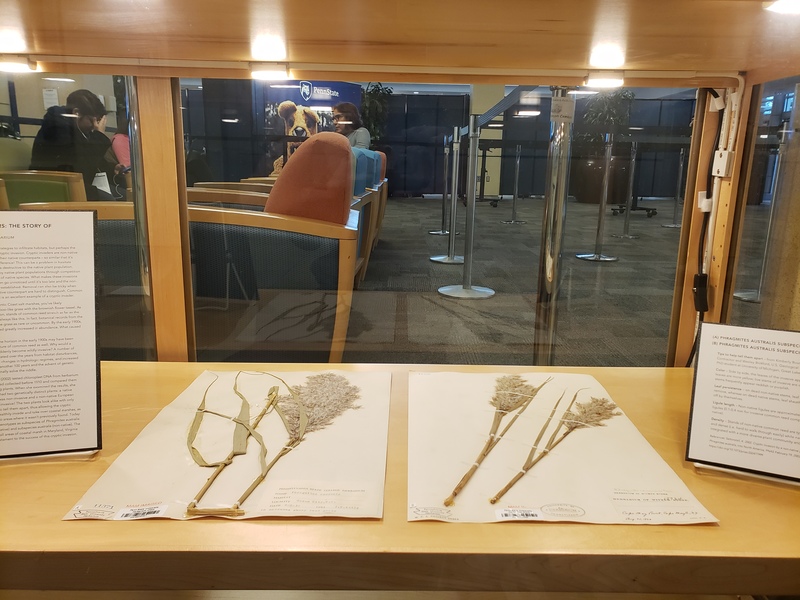Herbarium objects
Item
Title
Herbarium objects
Description
Cryptic Invaders: The Story of the Common Reed
Plant invaders use many strategies to infiltrate habitats, but perhaps the most insidious one is the cryptic invasion. Cryptic invaders are non-native plants that look similar to their native counterparts – so similar that it’s often difficult to tell the difference! This can be a problem in habitats where the cryptic invader is destructive to the native plant population. Cryptic invaders can destroy native plant populations through competition and eventual replacement of native species. What makes these invasions so devious is that they often go unnoticed until it’s too late and the non-native plant becomes well-established. Removal can also be tricky when non-native invader and native counterpart are hard to distinguish. Common reed (Phragmites australis) is an excellent example of a cryptic invader.
If you’ve ever been to Atlantic Coast salt marshes, you’ve likely encountered this tall bamboo-like grass with the brownish flower tassel. As you gaze toward the horizon, stands of common reed stretch as far as the eye can see. But it wasn’t always like this. In fact, botanical records from the 1800s typically describe the grass as rare or uncommon. By the early 1900s, however, common reed had greatly increased in abundance. What caused this change?
A scientist gazing out at the horizon in the early 1900s may have been puzzled at the invasive nature of common reed as well. Why would a seemingly docile plant suddenly become wildly invasive? A number of theories have been postulated over the years from habitat disturbances, stresses such as pollution, changes in hydrologic regimes, and increased soil salinity. It would take another 100 years and the advent of genetic technology, however, to finally solve the riddle.
In 2002, Kristin Saltonstall (2002) tested chloroplast DNA from herbarium specimens of common reed collected before 1910 and compared them to the DNA of actual living plants. When she examined the results, she realized that she actually had two genetically distinct plants: a native American genotype that was non-invasive and a non-native European genotype that was highly invasive! The two plants look alike with only subtle visual differences to tell them apart, thus allowing the cryptic European genotype to stealthily invade and take over coastal marshes, as well as expand its range to areas where it wasn’t previously found. Today we recognize these two genotypes as subspecies of Phragmites australis: subspecies americanus (native) and subspecies australis (non-native). The native is found only in small areas of coastal marsh in Maryland, Virginia and New Jersey, a sad testament to the success of this cryptic invasion.
Plant invaders use many strategies to infiltrate habitats, but perhaps the most insidious one is the cryptic invasion. Cryptic invaders are non-native plants that look similar to their native counterparts – so similar that it’s often difficult to tell the difference! This can be a problem in habitats where the cryptic invader is destructive to the native plant population. Cryptic invaders can destroy native plant populations through competition and eventual replacement of native species. What makes these invasions so devious is that they often go unnoticed until it’s too late and the non-native plant becomes well-established. Removal can also be tricky when non-native invader and native counterpart are hard to distinguish. Common reed (Phragmites australis) is an excellent example of a cryptic invader.
If you’ve ever been to Atlantic Coast salt marshes, you’ve likely encountered this tall bamboo-like grass with the brownish flower tassel. As you gaze toward the horizon, stands of common reed stretch as far as the eye can see. But it wasn’t always like this. In fact, botanical records from the 1800s typically describe the grass as rare or uncommon. By the early 1900s, however, common reed had greatly increased in abundance. What caused this change?
A scientist gazing out at the horizon in the early 1900s may have been puzzled at the invasive nature of common reed as well. Why would a seemingly docile plant suddenly become wildly invasive? A number of theories have been postulated over the years from habitat disturbances, stresses such as pollution, changes in hydrologic regimes, and increased soil salinity. It would take another 100 years and the advent of genetic technology, however, to finally solve the riddle.
In 2002, Kristin Saltonstall (2002) tested chloroplast DNA from herbarium specimens of common reed collected before 1910 and compared them to the DNA of actual living plants. When she examined the results, she realized that she actually had two genetically distinct plants: a native American genotype that was non-invasive and a non-native European genotype that was highly invasive! The two plants look alike with only subtle visual differences to tell them apart, thus allowing the cryptic European genotype to stealthily invade and take over coastal marshes, as well as expand its range to areas where it wasn’t previously found. Today we recognize these two genotypes as subspecies of Phragmites australis: subspecies americanus (native) and subspecies australis (non-native). The native is found only in small areas of coastal marsh in Maryland, Virginia and New Jersey, a sad testament to the success of this cryptic invasion.
Source
Rights
This image is posted publicly for non-profit educational uses, excluding printed publication. Other uses may not be permitted.

